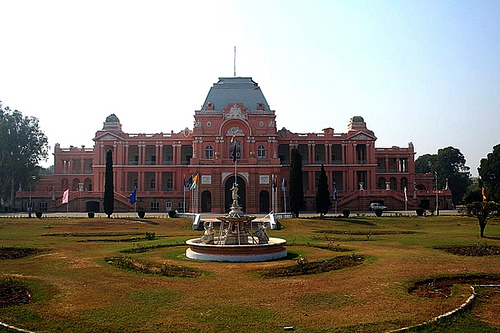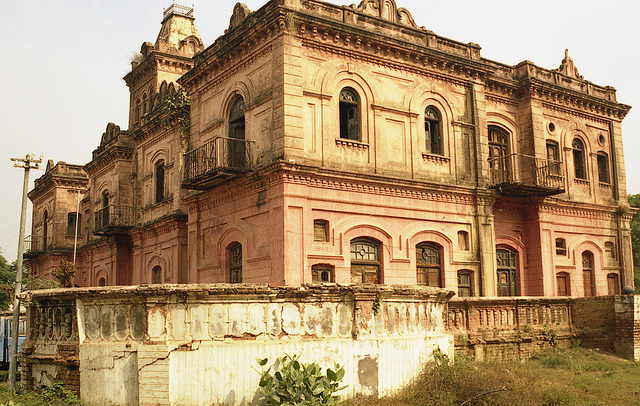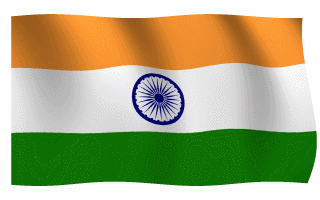
Kapurthala is situated in Doaba region at confluence of river Beas and Sutluj. It is the one of the earlier princely state. Maharaja Jagatjit Singh the last ruler of Kapurthala before independence, was a great enthusiast of French architecture, which is reflected from the palaces and various monuments of the city. It is known as ‘Paris of Punjab.
Kapurthala, as any other place in Punjab has been a land of Kings and has rich cultural and historical importance and significance. Structures and monuments of grandeur and beauty have been built in Kapurthala that add charm and visual delight to the place. Some of the important places and monuments in Kapurthala are Jagatjit Club,Moorish Mosque,Shalimar Gardens,Elysee Palace,Jagatjit Palace,Panch Mandir,Gurudwara Ber Sahib,Kanjli Wetlands
The spectacular Jagatjit Palace styled after the French palace of Versailles is like a bejeweled crown in the landscape of Punjab. The unique Moorish Mosque, Shalimar garden, Panj Mandir, the stately Durbar Hall, the beautiful Kamera garden complex with the majestic rest house etc are major places of tourist attraction. Add to these the other tourist attractions like the scenic Kanjli wetland bird sanctuary near kapurthala , the Pushpa Gujral Science City and above all Sultanpur Lodhi, all in one compact area, this region comes alive like an enduring celebration. This star studded necklace of a tourist circuit has all the potential to be a major international tourist attraction.
Pushpa Gujral Science City is Kapurthala’s other major tryst with modernity. A joint venture project of Governments of India and Punjab, it seeks to popularize science through ‘edutainment’- education and entertainment.
Apart from the Science City, the Punjab Technical University (PTU), Caparo School of Material Management (set up by Lord Swaraj Paul), the National Non-Conventional Energy Centre are all located on the Jalandhar-Kapurthala road, which is a stretch of only 24 kms and a traveling time of 30 minutes. In times to come, with planned development, Kapurthala, with a cleaner and greener environment, has the potential to be a better and cleaner satellite extension of Jalandhar, and has the potential to attract vast investments in urban development. What is required to realize this potential is the setting up of an independent Greater Kapurthala Development Authority, which could be the ideal mechanism to formulate, raise resources and implement major urban development projects, which is beyond the capabilities of the Municipal Committees. Another uniqueness about Kapurthala is that it is probably the only district in the country, one part of which (Phagwara), lies in the centre of another district (Jalandhar).
Phagwara is a thriving industrial town, located on the G.T road, between Ludhiana and Jalandhar. Phagwara is home for the famed JCT mills, Sukhjit Starch mills, Oswal sugar mills and a large number of automobile spare parts manufacturing units. The stretch of 15 km distance between Jalandhar and Phagwara has huge potential for commercial development, where a string of resorts and most modern multiplexes are coming up. In many ways Phagwara leads the rest of the Kapurthala district into the realm of growth and economic prosperity.
However for the District Administration, with a mandate to maintain peace, law and order and facilitate growth and welfare of the citizens, the agenda is more emergent in the social sector than economic. Drug addiction problem of youth, which has assumed demonic proportions, and low sex ratio / female feticide problem, are twin social problems of Punjab which can retard whatever economic prosperity there is, and tackling them is top agenda for the District Administration. The Kapurthala district is in many ways an unique and harmonious blend of the glorious past, pulsating present and a promising future.
What is probably the single most significant historical event of this region is the Enlightenment of Guru Nanak sahib in the year 1499, while bathing in the Bein rivulet, in the little town of Sultanpur Lodhi. It is after receiving this grace that he sowed the seeds of Sikh faith from here. Guru Nanak sahib spent 14 years of his life in this town, meditated under the Ber tree (which still exists) and journeyed from here to various parts of the world spreading the message of oneness. For anyone who imbibes his message, Sultanpur Lodhi is an overwhelming experience. It is this heritage of spiritualism that is evidenced even today in the peace-loving, harmonious and tolerant nature of the people of Kapurthala. It is in the rekindling of this lost spirit that the future of Punjab lies. The vestiges of the royalty that ruled Kapurthala still gloriously mark the present day city of Kapurthala.
It was one of the first cities in Punjab to get modern amenities like sewerage, drinking water and communication systems, which still work. The spectacular Jagatjit Palace styled after the French palace of Versailles is like a bejeweled crown in the landscape of Punjab. The unique Moorish Mosque, Shalimar garden, Panj Mandir, the stately Durbar Hall, the beautiful Kamera garden complex with the majestic rest house etc are major places of tourist attraction.
Add to these the other tourist attractions like the scenic Kanjli wetland bird sanctuary near kapurthala , the Pushpa Gujral Science City and above all Sultanpur Lodhi, all in one compact area, this region comes alive like an enduring celebration. This star studded necklace of a tourist circuit has all the potential to be a major international tourist attraction.

The Kapurthala district is in many ways an unique and harmonious blend of the glorious past, pulsating present and a promising future. What is probably the single most significant historical event of this region is the Enlightenment of Guru Nanak sahib in the year 1499, while bathing in the Bein rivulet, in the little town of Sultanpur Lodhi. It is after receiving this grace that he sowed the seeds of Sikh faith from here.
Guru Nanak sahib spent 14 years of his life in this town, meditated under the Ber tree (which still exists) and journeyed from here to various parts of the world spreading the message of oneness. For anyone who imbibes his message, Sultanpur Lodhi is an overwhelming experience. It is this heritage of spiritualism that is evidenced even today in the peace-loving, harmonious and tolerant nature of the people of Kapurthala. It is in the rekindling of this lost spirit that the future of Punjab lies. The vestiges of the royalty that ruled Kapurthala still gloriously mark the present day city of Kapurthala.It was one of the first cities in Punjab to get modern amenities like sewerage, drinking water and communication systems, which still work.
 Translate
Translate




